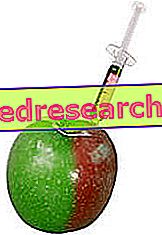See also: mercury toxicity
The problem of mercury
Mercury is one of the most feared heavy metals by consumers, alarmed by news that is periodically re-launched by the media. The Anti-Sophistication Unit Carabinieri, for their part, constantly monitor to prevent food with significant percentages of mercury from arriving on our tables. When large contaminated foodstuffs are intercepted, the news is immediately amplified by the media, triggering the so-called "mercury psychosis". Many of the consumers most attentive to their health find themselves so bewildered and, it is appropriate to say it, they no longer know what to do. Is it better to increase the consumption of fish products for their protein content and omega-3 fatty acids that are good for the heart, or reduce it to avoid the risk of mercury poisoning?
Mercury in nature and in industry
Mercury is a relatively abundant element in the entire earth's crust. Among all the metals it is the only one to be liquid at room temperature and as such, it is highly volatile. In this state, even if ingested, it is not very toxic but above all its vapors.

Mercury is also used in the manufacture of batteries, particularly in the "button" ones present in watches and electronic calculators. If they are unconsciously thrown into the environment or into bins along with the other waste, they inevitably end up contaminating the ground and aquifers.
Given the high toxicity of mercury, numerous campaigns have been promoted aimed at progressively reducing the use of the mineral in the industrial field. Thanks to these interventions, many of the traditional uses, including the old thermometer, have been considerably reduced.
Mercury contamination
The pace is short from industrial waste to our tables. The mercury, released into the environment through vapors or waste liquids, contaminates the soil, passes into the aquifers and from there enters the food chain. The toxicity of the mineral is considerably amplified by the bacteria that inhabit the aquatic seabed and, to a lesser extent, by the intestinal microflora of many animal species, including fish. These microorganisms transform inorganic mercury into its organic forms, among which the most widespread and dangerous is the methylated one (methylmercury). The high liposolubility gives these compounds the ability to go up the food chain, accumulating especially in the nervous tissue of smaller fish, which in turn transmit it to their predators. Thus, in general, the larger the size of the fish, the greater its mercury content.
On the other hand, the existence of micro-organisms capable of "detoxifying" methylmercuirium (some of which are of biotechnological derivation) and industrial plants capable of recycling metal, minimizing its environmental impact must be emphasized.
Toxicity of mercury
Ingestion of metallic mercury, for example following a thermometer rupture, has no major toxicological consequences. On the contrary, the vapors taken by inhalation are very harmful. If such an accident occurs, it is a good idea to immediately remove pregnant women and children, avoiding using a vacuum cleaner or broom to avoid contaminating the air. Instead, the mercury will be separated from the glass with the aid of a syringe, scotch tape or by rolling it on a sheet of paper. It must therefore be stored in a non-metallic container that is well closed and properly sorted (pharmacies are generally available in this regard). Illuminating the area where the accident occurred with a flashlight can detect any mercury residues and remove them with the techniques indicated above. Finally, before staying in it, it is good to air the room for a long time.
The methylmercury present in food and in particular in fish remains the most dangerous source of contamination. Pregnant women are the most exposed to the problem, since mercury can lead to alterations in the brain development of the fetus. In adults, chronic exposure causes neurological changes, with the appearance of fears, hallucinations, amnesia, to the point of causing exactly the symptoms of multiple sclerosis.
CONTINUE: Mercury in fish and food »



